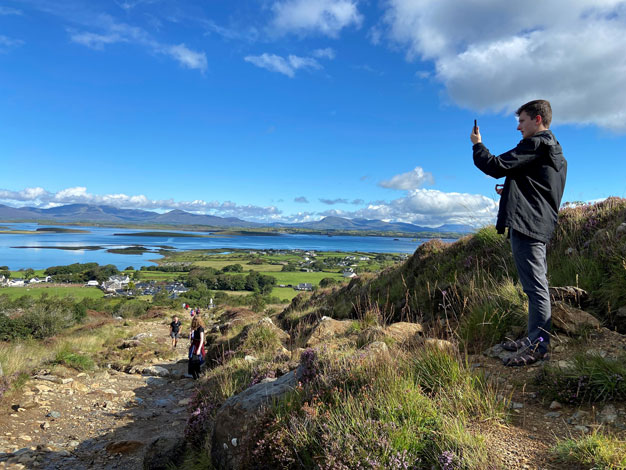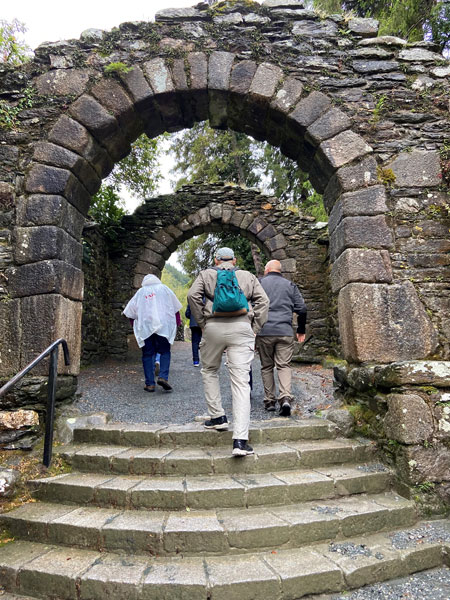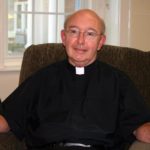
Matthew Teets captures a splendid view from Croagh Patrick mountain overlooking Clew Bay in County Mayo, Ireland, on Sept. 4 during The Catholic Messenger Pilgrimage to Ireland.
By Barb Arland-Fye
The Catholic Messenger
Thirty-three Catholics, most of them unacquainted with each other, journeyed together because of their shared yearning to explore and discover more about the faith of the Irish during The Catholic Messenger Pilgrimage to Ireland.
“In Celtic spirituality, ‘place’ is very important. Certain locales are considered ‘thin’ places, where the barriers between heaven and earth, the spiritual and the material, are especially porous,” Bishop Thomas Zinkula said in a letter to his co-pilgrims contained in their pilgrimage worship aid.
From Aug. 31, when they flew to Dublin to Sept. 9, when they returned to Davenport and points beyond, these Catholics of different ages and backgrounds became a close-knit community bonded in faith, friendship and shared appreciation for the people and places of Ireland.
“As we got to know one another, we developed a wonderful comradery and everyone got along well,” said Bishop Zinkula, the pilgrims’ spiritual leader. “The group truly approached our travels around Ireland as a pilgrimage, but that doesn’t mean we didn’t have a lot of fun together. After all, we did find our way to the Jameson distillery and the Guinness brewery!”
“Ireland is a beautiful country of beautiful people with a beautiful culture. Sadly, the Irish had to carry some ugly, heavy crosses for centuries,” Bishop Zinkula said. “The large cathedrals in large cities where we celebrated Mass, like St. Mary Pro-Cathedral, Dublin; St. Patrick, Armagh; St. Colman, Cobh, were impressive and awe-inspiring. But I really enjoyed celebrating Mass in small churches in enchanting, natural settings, like Holy Cross Abbey in County Tipperary, near the Rock of Cashel, and St. Kevin Church in Glendalough.”
Mass anchored the pilgrimage, sometimes celebrated in majestic cathedrals, sometimes in modest churches and other times in chapels — except for one mix-up that resulted in a prayer service celebrated in a hotel patio! Bishop Zinkula presided at the Masses and another pilgrim, Father Nick Adam of St. Mary Parish in Fairfield, served as concelebrant.
The faithful of Ireland
“I was a late applicant to the pilgrimage,” Father Adam said. “Touring through Ireland was a spiritual and faith-rewarding experience. I was humbled to be in the land of such saints as Patrick, Kevin, Brigid and Colman and to concelebrate Mass with Bishop Zinkula in churches, large and small, old and new. Especially enriching was our visit to Knock in County Mayo, and to hear the story of our Blessed Mother’s apparition in 1879 to the poor Catholics in that village. That place alone is worth a visit to Ireland. All in all, our few days in places of ‘sacred ground’ gave me lifelong memories and a deeper respect for our Catholic faith — a faith that lived in Ireland many centuries before it arrived in our United States.”

Pilgrims on The Catholic Messenger Pilgrimage to Ireland make their way into the monastic ruins of Glendalough on Sept. 8.
The pilgrims began their journey inside the Gothic-style St. Patrick Cathedral in Dublin, built on the site where St. Patrick is believed to have baptized pagan converts. “The building passed into the hands of the Anglican Church in the 16th century, after the Reformation. A century later, Oliver Cromwell’s puritanical Calvinist troops — who considered the Anglicans to be a little more than Catholics without a pope — stabled their horses here as a sign of disrespect” (Rick Steves Ireland).
Learning that St. Patrick in his teenage years was the victim of human trafficking by Irish raiding parties surprised some of the pilgrims, who watched a video on the life of the fourth century saint during their visit to Downpatrick in Northern Ireland. While the future saint eventually escaped and returned to his homeland, he selflessly returned to Ireland, called by God to bring Christianity to the people who enslaved him.
St. Kevin was another saint with whom the pilgrims became familiar in the ruins of a sixth-century monastery in Glendalough, which means the valley of two lakes. They stood in the rain, absorbed by a tour guide’s biographical sketch of St. Kevin and a historical account of the ruins of the monastery he founded. Vikings attacked the monastery but “Glendalough thrived as one of Ireland’s great ecclesiastical foundations and schools of learning until the Normans destroyed the monastery in 1214 A.D.” (visitwicklow.ie)
Knock Shrine in western Ireland, one of the world’s major Marian Shrines, left an indelible impression on the pilgrims, moved by the story of Mary’s appearance to 15 men, women and children in 1879 during a looming famine. The 15 witnesses said that Mary appeared with St. Joseph, St. John the Evangelist, and a lamb and a cross. The apparition gave people a sense of hope during a time of despair.
Special experiences
For Michael Mulligan of St. Mary Parish in Williamsburg, who participated in the pilgrimage with his wife, Helen, Knock Shrine topped the list of his experiences. “No wonder our blessed Lady visited at the lowest point in Ireland’s history…. When Bishop Zinkula held up the host (during Mass in the Apparition Chapel at Knock Shrine) and said, ‘Behold the Lamb of God who takes away the sin of the world,’ directly beneath the 3D replica of the lamb standing on top of the altar, my oh my. What an experience, and to see the images of Mary, Joseph and John and angels surrounding the altar. As the bishop said, ‘The veil of Heaven is thin in places.’ No thinner does it get than Knock.”
The pilgrims climbed a trail at Croagh Patrick, the mountain on which St. Patrick is believed to have fasted for 40 days. Many — but not all — of the pilgrims kissed the Blarney Stone at the top of Blarney Castle. They toured the strikingly elegant Kylemore Abbey and braved blustery winds to see the imposing, starkly beautiful Cliffs of Moher high above the Atlantic Ocean along Ireland’s western coast.
They visited a sheep farm and enjoyed scones and hot tea there. One evening they feasted on food, humor and music during a banquet in a medieval castle. They viewed an inspiring story about Father Patrick Peyton — founder of the global Family Rosary Crusade — in his hometown village of Attymass, Ireland. They toured the Jameson distillery and the Guinness Storehouse, sampling beverages at both places. They broke bread together and learned that pilgrim Tommy Hexter’s favorite number is 33, a number that figured prominently in the lives of some of the pilgrims. They were amazed by 16-year-old pilgrim Matthew Teets’ extensive knowledge of Ireland’s history and by his singing abilities.
“Pilgrims make God the intentional center of the journey, the One on whom they place their focus. They walk with open hands, accepting the gifts of what and whom they encounter. They know they are guests, privileged to be in any given place. Pilgrims are open to the unexpected for God is a God of surprises,” Bishop Zinkula said in his letter to his fellow pilgrims at the start of their journey.
“There were a number of unexpected events, which is par for the course with a group of 33 people who travel together for 10 days with a full itinerary,” the bishop said after returning home. “One of them was not being able to find hosts for an outdoor Mass next to one of St. Brigid’s wells (the weather was bad anyway).”
Pilgrims move reflectively and gently, with reverence for God’s presence in their midst. The pilgrimage inspired Winnie White of Indiana to offer a daily reflection on the tour bus in Ireland. She and her husband, Bob, entered the pilgrimage not knowing anyone but becoming friends with everyone. “Sometimes God wants us to step outside our comfort zone. That is where you grow,” Winnie said. “I do feel we grew on this trip, spiritually.” Bob added, “It’s a wonderful way for folks who don’t know each other to get together and make friends.” The common bond is a shared commitment to the Catholic faith, he said. “I feel so blessed.”











